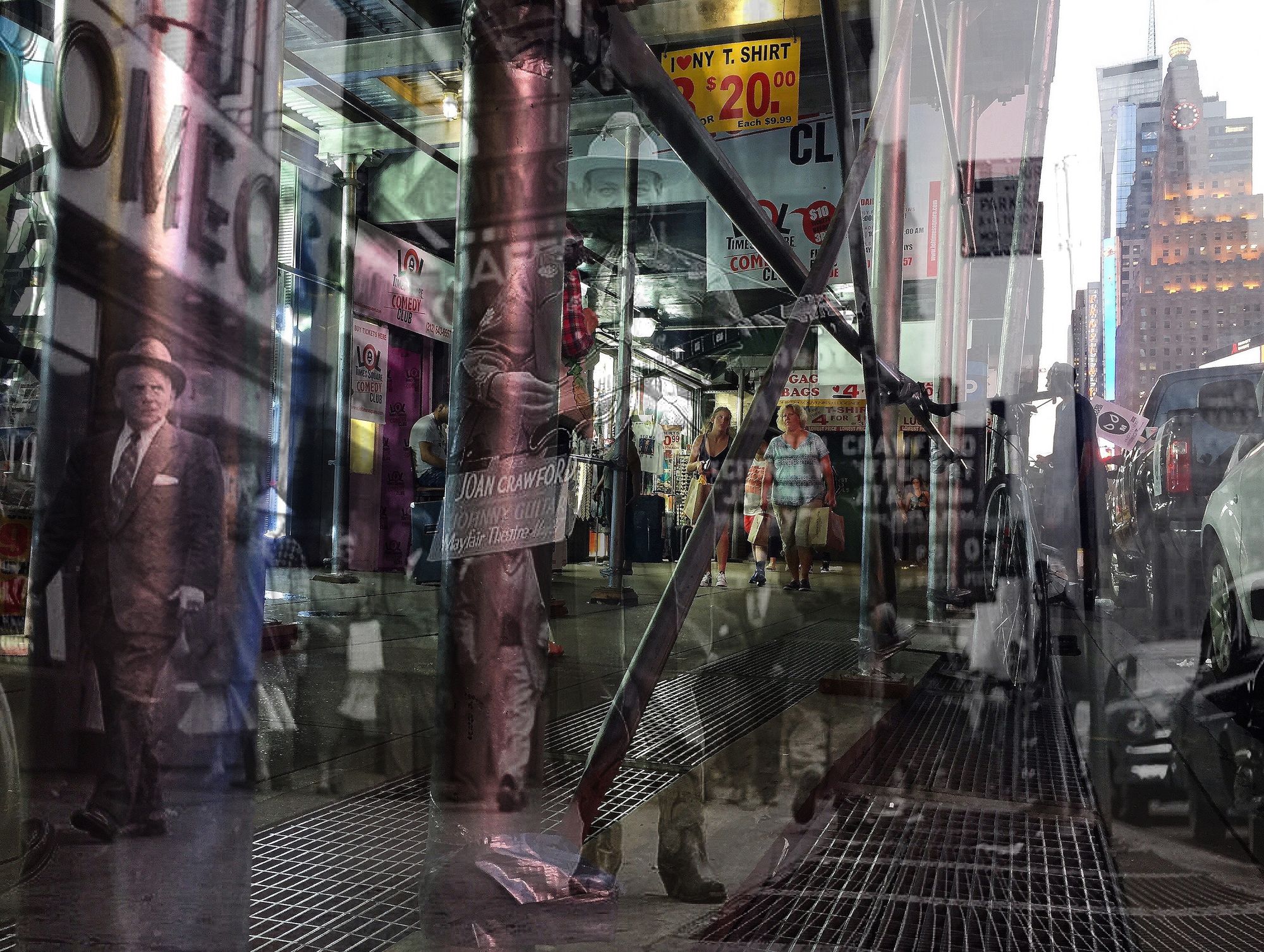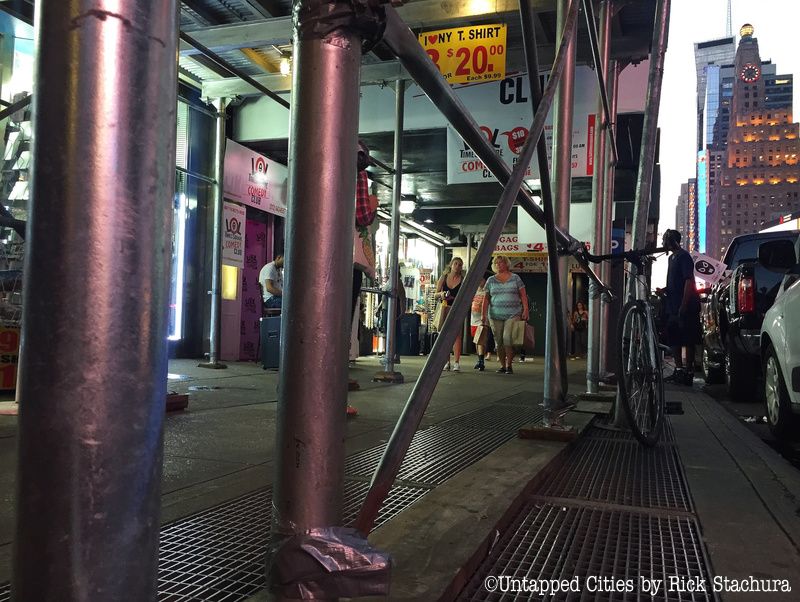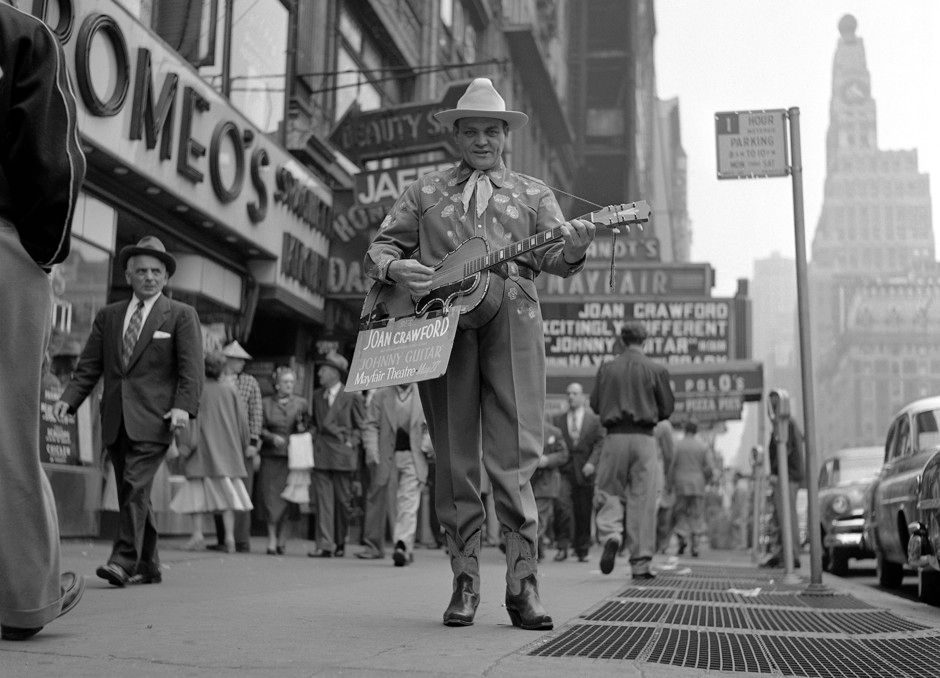

 A 1954/2017 overlay by Rick Stachura
A 1954/2017 overlay by Rick Stachura
In Martin Scorsese’s documentary Public Speaking [2010], Fran Lebowitz quipped:
If you’re a New Yorker and you run into another New Yorker in Times Square, it’s like running into someone in a gay bar in the ’70s. You—you instantly start making excuses as to why you’re there: “I’m not really here!” “I’m not really in the—I’m not really in Times Square!” “I’m on my way to somewh—I’m doing research!”
Well, things don’t get anymore Times Square than this. I’m walking south on the east side of 7th Avenue between 48th and 47th Streets. I’ve got the oncoming cover of dusk for camouflage but, in case anyone notices, I’m just here for research!

Actually, the middle of this block always intrigues me. Given the history here and the fact a few of these buildings are over the 75 year tenure mark, perhaps Lebowitz would give me a pass. You see that guy ringed by those “LOL” signs sitting left-center in my photo? He’s barking into a megaphone promoting a comedy show. I guess some things never change. The scene reminds me of one photographer Frank Oscar Larson (1896-1964) captured from this same spot 62 years ago:

Photo by Frank Oscar Larson. 1954. Used by Rick Stachura with permission from Soren Larson.
Like today’s elocutionist, Larson’s singing cowboy was pushing a show then too: Nicholas Ray’s film Johnny Guitar [1954] starring Joan Crawford. Her name adorns the marquee of the Brandt’s Mayfair Theater in the background at 47th Street. According to imdb.com, the film debuted in New York City on May 26 and the Mayfair had the honor of hosting its first screening. The placard hanging from the cowboy’s guitar reads “May 27,” so most likely Larson snapped his photo on May 27, 1954. Writing in The New York Times on May 28th, Bosley Crowther summed up his rather cranky review of the film with this:
The color is slightly awful and the Arizona scenery is only fair…. Let’s put it down as a fiasco. Miss Crawford went thataway.
Although modern critics would eventually be kinder to Crawford’s performance—especially in scenes with co-star Mercedes McCambridge—the fate of the old theater was quite different. The building that held the Mayfair on the corner of 7th Avenue and 47th Street—707 7th Avenue, aka 701-709 7th Avenue—ceased operating its theater business in 1998. Sadly, after 105 years of existence, 707 was demolished in 2015—hence all the scaffolding. When completed, the Mayfair’s replacement will be a 42-story hotel, mixed retail extravaganza. It will be known as 701 7th Avenue.
Amazingly, though, there’s still a few things around from 62 years ago. For example, in the upper right hand corner of my shot, you can make out the old clocktower that once belonged to the Paramount Theatre (1926-1966) on Broadway and 43rd Street. Today it marks time atop the Hard Rock Cafe. My favorite hangers-on, though, are stationed at ground level: the subway grates. All these years later and they haven’t been moved. The furrows in the sidewalk haven’t been altered either. Notice that old parking meter right-center in Larson’s photo? Although it’s long been uprooted, a trace of its footprint still exists. There’s four shaved off bolts buried just below the sidewalk’s surface that must have once anchored the meter.
By the way, did you spot that arrow behind our cowboy’s hat that reads “BEAUTY JAF”? Well, if it was still with us, the arrow would be pointing to the entrance of today’s Embassy Gifts on the first floor of 717 7th Avenue. At the time of Larson’s image, however, you can see that it guided the eye toward Romeo’s Spaghetti Kitchen. (Another of Romeo’s locations was at 1936 Broadway). On the second, of course, was the place that arrow advertised: Jaffry’s Beauty Shop. Meanwhile, out of the frame, the building’s third floor housed a school of music specializing in “natural playing instruction” and its fourth held a rather revered spot for bodybuilders: Sigmund Klein’s Gymnasium or, as some sources prefer, Sig Klein’s Studio of Physical Culture. Too bad, though, Larson wasn’t able to capture the apparently huge placard of Klein’s (1902-1987) chiseled torso that hung from the building’s cornice.

A 1954/2017 overlay by Rick Stachura
What really seduces me about this block, though, is where today’s ticket peddler is situated. He’s at 711 7th Avenue—aka 711-715 7th Avenue—and next to him on the ground floor is Playland Gifts. As you can see from the “POLO’S” insignia on the awning in Larson’s shot, back then it was Marco Polo’s Restaurant. Behind our ticket man is a passage that leads to the LOL Times Square Comedy Club, a quick stair climb to the second floor. In Larson’s time, this was the entrance to Honeymoon Lane Dance Land, an apparently popular taxi-dance ballroom that was either on the second floor or in the basement of 711. (According to the building’s 1962 certificate of occupancy, there were separate “restaurant and cabaret” operations on both levels, so it’s hard to guess which).
Regardless, Honeymoon Lane was forced to close in 1964 when Bernard J. O’Connell (1911-1986), New York’s Commissioner of Licenses, wouldn’t renew its operating permit. As the Times reported then, O’Connell said the place was “being used for immoral, lewd, and obscene purposes.” Furthermore, he charged that taxi-dance halls like the Honeymoon Lane were “frequented by male patrons in search of sexual experiences and adventures with hostesses.” I wonder, though, if he knew about scene unfurling on the third floor of the building.
In Larson’s time, the third floor of 711 7th Avenue was home to an establishment referred to as Paddy’s 7-11, the 7-11, or just plain Paddy’s: “the biggest poolroom of big-time pool.” Writing in his book Hustler Days [2003], R. A. Dyer declared that
From about 1949 until the early 1960s, a player could find no fiercer competition than at New York’s 7-11. Marriage had taken the suckers; suburbia had destroyed the roadman economy. America’s last great hustlers came to the 7-11 like sharks drawn to blood. They schooled together, hoping, hunting, searching for money and glory in darkening waters….
[It was a] magical scene where twenty-one tall bell-shaped lamps drooped over twenty-one unforgiving tables.
David Baker, an author and acquaintance of mine who began to patronize the 7-11 in 1962, offered this description:
The bright lights shining down from the 3rd floor onto 7th Avenue did attract tourists and out-of-towners, many of whom thought they could play pool. So for awhile it was a hustler’s paradise, easy pickings, as it were. College kids, doctors from Buffalo, salesmen from Topeka; they all came up the stairs, and they all went back down the stairs—broke, or with just enough money to get back to Topeka.
There was also a curious piece of lingo Baker mentioned some of the hustlers using there. In particular, he associated it with one of the guys called “Doc,” perhaps short for the “extraordinary one-pocket player Doc Gallagher.” He reminisced:
What made Doc stand out was his ability to hustle the hustlers when the room ran out of suckers, also gaming the serious players. Very difficult to “clock” (read), he was a masterwork of deception, never one to “run out” that is, often winning by the narrowest margins. You know, by “luck.”
There was an expression back then that went something like this: “He gave ’em polio,” which meant the opposing player could barely hold his stick, much less beat the particular player. Doc fit into that category, often inflicting “polio” on opposing players.
Eventually, though, that sense of polio began to afflict the hustlers themselves. Because the 7-11 was open 24 hours a day/seven days a week, Dryer observed that
It became a midnight refuge for the forlorn and unwary. [All the pros] were all there: Three-Fingered Gus, Wagon Head (he never stopped waggin’ his head), New York Blackie, Joey with Glasses. They stumbled by the prostitutes, over the stairwell-sleeping bums beneath newspaper blankets. The smoke and the crack of shots drew them. The promise of easy money and cheap fame enslaved them. The stink of it clung to them like old sweat.
And Baker confirmed that, by the time he arrived on the scene,
The 7-11 and Ames [Billiard Academy on the second floor of 160 West 44th Street] had essentially become dives, well past their prime. And somewhat surprisingly, a portion of the big action could sometimes be found way out in Queens, like going to Canada…. But, eventually, it all came to an end. The era was over, many of the top players scattering to the four winds.
I’m not sure when the 7-11 passed on, but it was definitely before 1972. By then, the building’s certificate of occupancy depicted the third floor with “offices” and a “physical culture establishment”—perhaps harbingers of the porn theaters that would one day open below. But, at least for a few minutes here, I can conjure the image of Sig Klein or Three-Fingered Gus, maybe ascribe a few lyrics to that guitar slinging cowboy when he bellowed up and down the block:
A man can lie, steal, or even kill…but he can’t top Crawford on today’s balladic double-bill. Saddle up now, you hear?
(Author’s Note: The son of Swedish immigrants, Frank Oscar Larson was born in Greenpoint, Brooklyn and became a long-time resident of Flushing, Queens. An avid photographer, he became even more committed to his discipline during the 1950s. On weekends, he’d leave his 9-5 banking job behind and open the aperture of his Rolleiflex Automat Model 4 camera upon the city. Thankfully, his son David’s widow Carole discovered the thousands of negatives and prints he left behind in 2009, and many have finally become public courtesy of his grandson Soren. You can check out the website Soren built for his grandfather at franklarsonphotos.com or, better yet, you can see some of Larson’s photos in person right now at Flushing Town Hall. A new presentation of his work is on display there on from 12-5 on Saturdays and Sundays until August 6th, 2017.
R.A. Dyer is a columnist for Billiards Digest and a statehouse reporter for the Fort Worth Star-Telegram. He currently lives in Austin, Texas. You can explore his love for all things pool-related and pick up one of his books at poolhistory.com.)
Next, read The Top 10 Secrets of Times Square NYC and Vintage Photos: The Evolution of Times Square from 1898 to Today.

